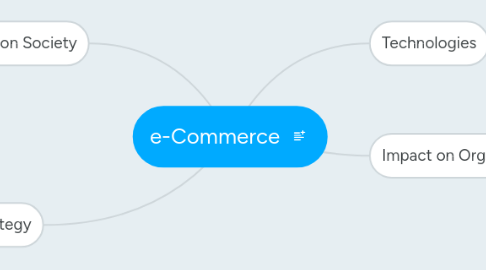
1. Technologies
1.1. Hardware
1.2. Software
1.2.1. Database systems
1.3. Networking
1.3.1. TCP/IP addresses
1.3.2. Ports and protocols
1.3.3. Considerations
1.3.3.1. Domain names
1.3.3.1.1. Multiple registration of domain
1.3.3.2. Programming requirements
1.3.3.3. Download speeds
1.3.3.4. Browser and platform compatibility
2. Impact on Organisations
2.1. Benifits
2.1.1. Global marketplace
2.1.2. 24 hour trading
2.1.3. Relatively low start-up and running costs
2.1.4. Competitive edge
2.1.5. Search facilities
2.1.6. Gathering customer information
2.1.7. Alternative income sources
2.1.8. Pricing opportunities
2.1.8.1. Differences
2.1.8.2. Fluid pricing
2.2. Drawbacks
2.2.1. Consumer trust
2.2.2. Lack of human contact
2.2.3. Delivery issues
2.2.4. International legislation
2.2.5. Product description problems
2.2.6. security issues
2.3. Promotion
2.3.1. SEO
2.3.1.1. Meta tags
2.3.1.2. spiders
2.3.1.3. Organic and paid results
2.3.2. Newsgroups and forums
2.3.3. Banners and pop-ups
2.3.4. Spam
2.3.5. Site name
2.3.6. Direct marketing
2.3.7. Ensuring an effective user interface (UI/UX)
2.3.8. Establishing Customer loyalty in a virtual environment
2.4. Security (issues)
2.4.1. Prevention of hacking
2.4.2. Viruses
2.4.3. Identity theft
2.4.4. Firewall impact on site performance
2.4.5. SSL
2.4.6. HTTPS
2.4.7. RSA certificates
2.4.8. Strong passwords
2.4.9. Alternative authentication methods
2.5. Legislation
2.5.1. Data Protection Act 1998
2.5.2. Computer Misuse Act 1990
2.5.3. Consumer Credit Act 1990
2.5.4. Trading standards
2.5.5. Freedom of Information Act 2000
2.5.6. Copyright legislation
2.5.7. e-Commerce Regulations
3. Effects on Society
3.1. Entities
3.1.1. e-Tailers (online only)
3.1.1.1. Amazon.com
3.1.1.2. ebuyer.co.uk
3.1.2. Financial Services
3.1.2.1. esure.com
3.1.2.2. Banks
3.1.3. Manufacturers
3.1.3.1. Dell
3.1.4. Existing retailers
3.1.4.1. Tesco.com
3.1.4.2. Argos.co.uk
3.1.5. Consumer led
3.1.5.1. eBay
3.1.6. Service providers
3.1.6.1. easyJet.co.uk
3.1.6.2. Lastminute.com
3.2. Payment systems
3.2.1. Electronic Checque
3.2.2. Paypal
3.2.3. NoChex
3.2.4. Credit or debit cards
3.3. Social implications
3.3.1. Changing customer perspective
3.3.1.1. Providing added value
3.3.1.2. Providing service
3.3.1.3. Ease and security
3.3.2. Economic and social impact due to speed of changes
3.3.3. Bricks and clicks (integrating online and high street)
3.3.4. Benefits for customers
3.3.4.1. Remote shopping
3.3.4.2. Access to goods and services for the housebound
3.3.4.3. Anytime access
3.3.4.4. Internet discounts
3.3.5. Drawbacks
3.3.5.1. Payment security
3.3.5.2. Assessing quality/fit without the product
3.3.5.3. Reliance on delivery services
3.3.5.4. Impact on enployment
3.3.5.5. Social divide
4. Strategy
4.1. E-commerce strategy
4.1.1. Structure of site
4.1.2. Hosting
4.1.3. Promotion
4.1.4. Issues
4.1.4.1. Cost
4.1.4.2. Security
4.2. Structure
4.2.1. Customer interface
4.2.1.1. Ease of use
4.2.1.2. Display of products
4.2.1.3. Personal details entry
4.2.1.4. Credit card entry
4.2.1.5. Other types of payment
4.2.1.6. Delivery details
4.2.2. Style
4.2.3. Image
4.3. Hosting
4.3.1. Choice of ISP
4.3.2. In-house or subcontract
4.4. Promotion
4.4.1. Marketing
4.4.1.1. Advertising the site
4.4.1.2. Placing in search engine
4.4.2. Message board
4.4.3. Chat rooms
4.5. Costs
4.5.1. Setup
4.5.2. Maintenance
4.5.3. Security
4.5.4. Leasing
4.5.5. Advertising
4.5.6. Delivery strategy
4.5.7. Staff training
4.6. Security
4.6.1. Fraud protection
4.6.2. Hackers
4.6.3. Viruses

